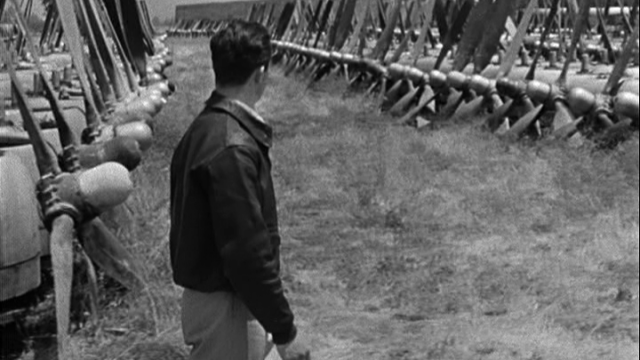The Best Years of Our Lives begins with a man trying to get home. The war is over, but there’s a problem with his flight; being a bombardier no longer means much. Pretty soon we find there are dozens of men in the same position, waiting for flights that have been canceled or changed. Eventually, the bombardier, Fred Derry, learns he and another man waiting — a sailor — will be able to get to his hometown in Boone City the next morning if he doesn’t mind taking a plane with a lot of stops. Neither man does. Derry signs his name on the necessary paperwork and the sailor goes to do the same.
That’s when we notice the hook that the sailor uses to hold his pen. He good-naturedly shrugs off offers of help from Fred and the sergeant acting as desk clerk: “You think I don’t know how to spell my own name?”
“I just thought—”
“I know, Sarge,” Homer Parrish says casually, and we see the second hook as he holds the paper in place.
Anyone expecting a ticker-tape parade or a string of Greatest Generation clichés has just been informed of their error. And we’re only five minutes into the picture. Soon, they’ve met Al Stephenson, a sergeant, and are flying home together. The opening scenes show the men full of hope, optimism, and fear. All three of them hesitate when it’s time to actually leave each other’s company and go home.
The Best Years of Our Lives feels shockingly frank for a modern viewer, who has heard decades of hagiography about the Second World War and has likely seen dozens of clean-cut, Ozzie-and-Harriet views of postwar life. The war had been over for less than two years when The Best Years of Our Lives premiered, and the movie dives into all of the stresses of post-war life with a care and frankness that’s rare even today.
Fred, like many men, married a woman he didn’t know that well, and he and his wife become frustrated quickly when he can’t find a better job than his pre-war position as a soda jerk. Al struggles to reconnect with his family and drinks too much. Homer can produce a cigarette and light a match, and he speaks of his injury casually. But there’s one thing that bothers him: his relationship with his girl back home. She hasn’t seen the hooks, “she hasn’t seen anything like these hooks.” (When he reunites with his family and fiancée — the literal girl next door — he struggles to embrace her, and there’s a tremendous moment where his family sees the hooks for the first time.)
In The Best Years of Our Lives, the trauma of the war is raw and fresh, and the movie doesn’t shy away from that pain. It does this without long monologues about wartime atrocities or even focusing much on these veterans’ years of service. Instead, it shows the messy, difficult reality of life after war, as well as the joys (Myrna Loy is absolutely luminous as Millie when she sees her husband again for the first time in years). Director William Wyler, a veteran himself, emphasized a naturalistic look, insisting that sets be built life-sized rather than extra-large to accommodate cameras and equipment and casting Harold Russell, a physically disabled veteran with no previous acting experience, as Homer, an act that is still pretty revolutionary.
Russell, who Wyler had spotted in a propaganda film called Diary of a Sergeant, had to be persuaded to take the part of Homer. He didn’t feel like he had the experience for the part. But he pulled two Oscars for his natural, layered performance — Best Supporting Actor and an honorary award for “bringing aid and comfort to disabled veterans through the medium of motion pictures.” (The Academy had thought he wouldn’t win. Maybe they should have done that for Chadwick Boseman.) Both Oscars were well-deserved.
The Best Years of Our Lives looks unflinchingly at the struggles of life after the parades have stopped, including topics like divorce and what we would now call PTSD. Even more than the stellar performances and technical excellence, the film’s great clarity and compassion makes it feel fresh, even seventy-five years later.
Worth checking out:
A lovely tribute to Harold Russell in the LA Times.
Author and therapist Rachel Manija Brown wrote a thoughtful three-part essay about PTSD that briefly touches on the way mental trauma is addressed in postwar fiction.


